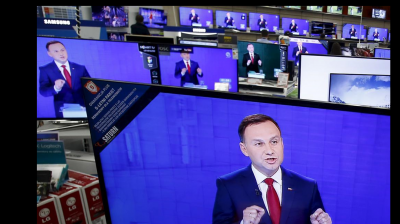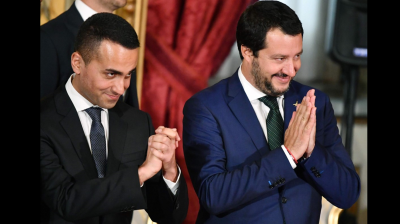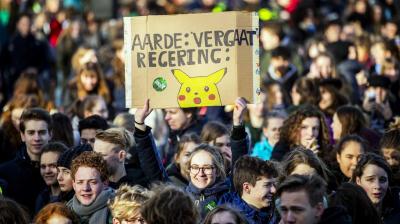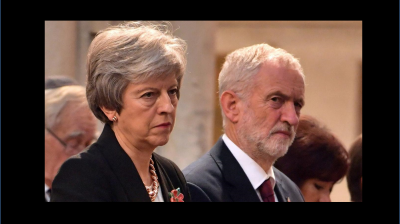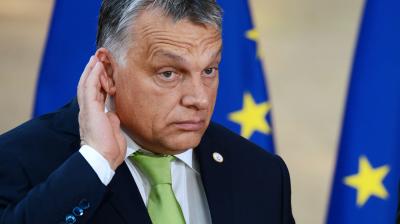The campaign for the European Elections in France
There were good reasons to think that ‘this time it will be different’ – that this time the campaign for the European elections would attract attention from the media and voters in France. These elections are indeed the first electoral test for President Macron, nearly two years after his unexpected success. Moreover, this young president decided to play openly a pro-European card during the 2007 presidential campaign and since. He advanced an ambitious agenda for the EU – for instance in a speech at La Sorbonne in September 2017. He staged himself as the leader of the pro-EU camp, by contrast to populist leaders inside France as well as outside. See for instance this video, broadcast by the French government in October 2018, where images of Salvini and Orban are shown in order to call for voting to the European elections with this slogan: “In May 2019 Europe will change: you should decide in which direction”.
Another reason for the hope placed in the European elections was the change of the electoral rules. The French Parliament decided last year that the elections should be organised within a single national constituency. From 2004 to 2014, the elections took place within eight artificial constituencies, which limited their saliency. It was more difficult to identify a party with a given candidate, due to the multiplicity of the lists from all regions. In 2019, the system went back to what had existed from 1979 to 1999: a single constituency, providing for a clear and visible political fight – which President Macron probably sought out with a desire to exacerbate the differences between him and the radical right.
Yet, those expectations have been so far (in late April 2019) disappointed. Indeed, the yellow vest movements, which started in November 2018, attracted nearly all the attention for several reasons: it is an unprecedented movement, it continues Saturday after Saturday, and some demonstrations have been accompanied by pillages and violence against the police. In reaction, Macron launched “Le Grand Débat National”, an impressive series of online and local consultations that took place between January and March 2019. He was supposed to deliver his conclusions and decisions resulting from those gatherings on the 15th of April but had to postpone his announcement as a result of the burning of the Notre-Dame cathedral in Paris. Finally, it was only on the 25th of April – one month before the elections - that Macron gave his important speech that is presented as the major roadmap for the second half of his term.
As a result of those unexpected events, French politicians, journalists and citizens have other things in mind than the elections to the European Parliament. Those elections have been mainly mentioned through anecdotes and the politics of list making. Anecdotes first: a TV debate organised on the 4th of March with no more than 12 candidates was preceded by justice decisions, according to which the channel was forced to invite small candidates for matters of equal treatment. As a result, this debate was rather untidy to say the least. Another anecdote has been the scoop that the leader of Macron’s list, the former European affairs minister Nathalie Loiseau, had been candidate for an extreme-right list decades ago – a particular embarrassment, as she has been presenting herself as a bulwark against populist forces.
''Many parties decided to run alone for those elections with the hope that they could deliver an unexpected performance, as has been the case in France in past European elections for both anti-EU and pro-EU parties.''
The politics of list making constituted the main source of media treatment of the campaign up to May 2019. Two questions arose: which parties would present a list and who would lead the lists? Many parties decided to run alone for those elections with the hope that they could deliver an unexpected performance, as has been the case in France in past European elections for both anti-EU and pro-EU parties. A center-right party, the UDI, usually associated with the right, decided to do so. On the left, small forces resulting from the collapse of the socialist party presented their own lists: the greens (Europe écologie les verts), the socialists associated a new group of intellectuals (Place publique), the socialist candidate to the last presidential election, who decided since to split (Benoît Hamon within Génération.s), the communists, the Trotskyists, and last but not least, a radical-left group who gained nearly 20 % of the vote in the previous election (La France insoumise, led by Jean-Luc Mélenchon). The chronicle of the difficulties of those parties to agree occupied most of the press articles. Tellingly, those papers were more focused on the state of the left and its future at the domestic level than on the European views of those parties.
''Macron’s list is one of the few that does not follow this “Macronian” strategy''
Another source of interest has been the selection of list leaders. In a context where Macron was successful in renewing the National Assembly in 2017, nearly all parties followed his strategy for the European elections, selecting young candidates and/or non-professional politicians. The National Rally’s (radical right, formerly National Front) leading candidate, Jordan Bardella, is 23 years old, and the radical-left leading candidate, Manon Aubry, is only 29 (for La France insoumise). The Republican (right) leading candidate, François-Xavier Bellamy, was unknown beyond traditional catholic circles. The leader of the socialist list, Raphaël Glucksmann, is not actually socialist. Ironically, Macron’s list is one of the few that does not follow this “Macronian” strategy, with - seemingly after much hesitation - the choice for Mrs Loiseau. This perhaps suggests that Macron feared a kind of attrition of his disruptive choices and needed to develop a solid and credible party – able to be influential within the ALDE group in the EP.
Beyond politics and tactics, a central, and even nearly unique, issue of the campaign has been the environment. While environmental issues are a source of concern, as in other member states, the yellow vest movements also expressed a reaction against green policies – especially regarding petrol taxation. As a result, nearly all candidates developed environmental issues. The greens are emphasizing a kind of purity on that issue and their past actions in the European Parliament. The radical left stresses that social and environmental concerns should go hand in hand. The right tries to develop with the philosopher Bellamy an original synthesis between conservatism and environment. By contrast, the issue of withdrawing from the EMU or even the EU is much less developed. Only two small radical right-wing groups openly support a “Frexit” (Asselineau and Philippot – a former advisor to Marine Le Pen).
In short, France has difficulties finding the right colour for the European elections. Although there were hopes that this time the “blue” of the European debate would prevail, the campaign seems to hesitate between the yellow of the famous vests and the green of the environmental issue, running the risk that, in the end, only the grey of a dull election will be remembered.




